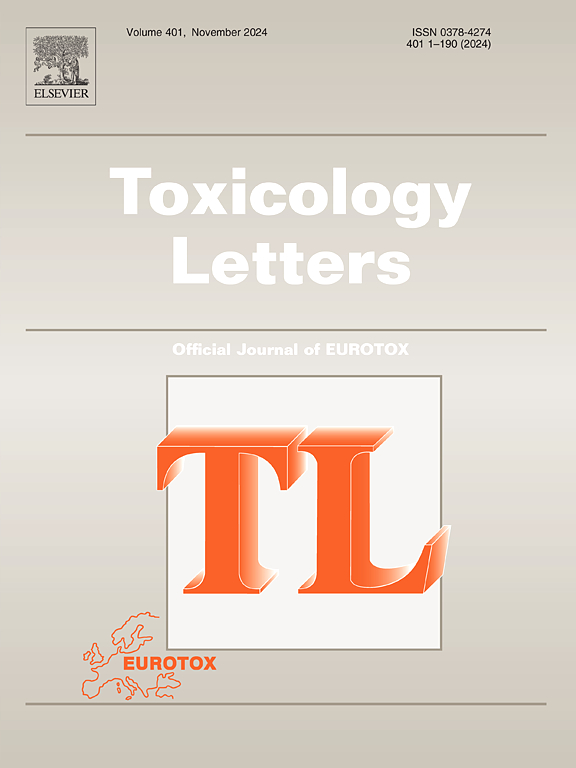NR1D1 mitigates IL-17a-induced small airway remodeling in biomass smoke-induced COPD
IF 2.9
3区 医学
Q2 TOXICOLOGY
引用次数: 0
Abstract
Introduction
Biomass smoke (BS) exposure is a critical environmental risk factor for Chronic Obstructive Pulmonary Disease (COPD). In this study, mechanisms of biomass smoke (BS)-induced small airway disease are explored, with a focus on the roles of Interleukin-17a (IL-17a) and Nuclear Receptor Subfamily 1 Group D Member 1 (NR1D1).
Methods
This study included 20 BS exposure COPD (BS-COPD) patients and 13 controls, who underwent chest high-resolution computed tomography (HRCT) scans to assess emphysema and small airway disease. The control group was divided into a low- and high BS exposure control group. Serum IL-17a levels were measured. Wild-type and IL-17a-/- B6/C57 mice were exposed to wood smoke to establish a COPD model in mice. Airway pathology was evaluated by histological analysis. The effects of IL-17a and NR1D1 on cell proliferation of BEAS-2b cells exposed to wood smoke particulate matter 2.5 were assessed in vitro using flow cytometry and Western blotting.
Results
HRCT revealed significantly higher small airway disease and emphysema in BS-COPD patients compared to controls (p < 0.01). Small airway disease exhibited the strongest negative correlation with FEV1%predicted (r = -0.61, p = 0.004). High-exposure control group showed significant BS Index correlations with small airway disease (r = 0.81, p = 0.049) and emphysema (r = 0.87, p = 0.025). Serum IL-17a levels correlated with small airway disease in BS-COPD (r = 0.48, p = 0.033). The mouse model demonstrated higher airway wall thickness and small airway disease in IL-17a-/- mice exposed to wood smoke. In vitro, IL-17a promoted BEAS-2b cell proliferation, an effect enhanced by NR1D1 downregulation.
Conclusions
BS exposure drives emphysema and small airway disease in non-COPD individuals. NR1D1 downregulation exacerbates IL-17a–mediated remodeling in vitro, suggesting therapeutic potential.
Trial registration
ChiCTR-OOC-16008692
NR1D1减轻il -17a诱导的生物质烟雾诱导的COPD小气道重塑
生物质烟雾(BS)暴露是慢性阻塞性肺疾病(COPD)的关键环境风险因素。本研究探讨了生物质烟雾(BS)诱导小气道疾病的机制,重点探讨了白细胞介素-17a (IL-17a)和核受体亚家族1D组成员1 (NR1D1)的作用。方法本研究纳入了20例BS暴露性COPD (BS-COPD)患者和13例对照组,他们接受了胸部高分辨率计算机断层扫描(HRCT)来评估肺气肿和小气道疾病。对照组分为低BS暴露对照组和高BS暴露对照组。测定血清IL-17a水平。采用柴火熏制野生型和IL-17a-/- B6/C57小鼠,建立小鼠慢性阻塞性肺病模型。气道病理通过组织学分析评估。采用流式细胞术和Western blotting检测IL-17a和NR1D1对暴露于木材烟雾颗粒物2.5的BEAS-2b细胞增殖的影响。结果shrct显示,BS-COPD患者小气道疾病和肺气肿发生率明显高于对照组(p <; 0.01)。小气道疾病与fev1 %预测值负相关最强(r = -0.61,p = 0.004)。高暴露对照组与小气道疾病(r = 0.81,p = 0.049)和肺气肿(r = 0.87,p = 0.025)的BS指数相关性显著。血清IL-17a水平与BS-COPD小气道病变相关(r = 0.48,p = 0.033)。IL-17a-/-暴露于木材烟雾的小鼠模型显示出更高的气道壁厚度和小气道病变。IL-17a在体外可促进BEAS-2b细胞增殖,下调NR1D1可增强这一作用。结论sbs暴露可导致非copd个体的肺气肿和小气道疾病。NR1D1下调加剧il -17a介导的体外重塑,提示治疗潜力。审判registrationchictr -记录- 16008692
本文章由计算机程序翻译,如有差异,请以英文原文为准。
求助全文
约1分钟内获得全文
求助全文
来源期刊

Toxicology letters
医学-毒理学
CiteScore
7.10
自引率
2.90%
发文量
897
审稿时长
33 days
期刊介绍:
An international journal for the rapid publication of novel reports on a range of aspects of toxicology, especially mechanisms of toxicity.
 求助内容:
求助内容: 应助结果提醒方式:
应助结果提醒方式:


